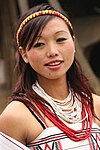Munda people
The Munda are found mainly concentrated in the south and East Chhotanagpur Plateau region of Jharkhand,[8] Odisha and West Bengal.[1][9] The Munda also reside in adjacent areas of Madhya Pradesh as well as in portions of Bangladesh, Nepal, and the Indian state of Tripura.According to linguist Paul Sidwell, Munda languages arrived on the coast of Odisha from Southeast Asia approximately 4,000 to 3,500 years ago (c. 2000 – c. 1500 BCE).[17][18] The Munda people initially spread from Southeast Asia, but mixed extensively with local Indian populations.Their presence in texts compiled in the upper Gangetic basin late in that period suggests that Munda speakers were there at the time.[23] In the late 1800s, during the British Raj, the Mundas were forced to pay rents and work as bonded labourers to the zamindars.The priest "Deori" is also prevalent among Hos, Bhumij, Bhuyan, Sounti, Khonds tribe of Odisha and Chutia people of Assam.[37] According to Sarat Chandra Roy, Sindurdaan ceremony and turmeric use in marriage clearly reflect Hindu elements borrowed into Munda tradition.[38] Munda people of Jharkhand also follow the age old tradition of Patthalgari, i.e., stone erection, in which the tribal community residing in the village buries a large inverted U-shaped dressed headstone on the head side of a grave or at the entrance to the village, in which is inscribed the family tree of the dead persons.[42] In a 2016 research paper on subsistence strategies of Mundas in a village of Sunderbans in West Bengal, it was found that many people migrate out of their residences because of poor economic conditions and landlessness.Men and women engage in forest product collection, cultivation, small business and agricultural as well as non-agricultural jobs.







Naga woman
Munda peoplesDinajpur District, BangladeshBangladeshJharkhandOdishaWest BengalChhattisgarhTripuraMadhya PradeshMundariPanchparganiaBengaliHinduismSarnaismChristianityBhumijsKhariasJuangsSanthalsAustroasiaticethnic groupIndian subcontinentMunda subgroupAustroasiatic languagesChhotanagpur Plateauscheduled tribesKolhan regionheadmanChotanagpurKhuntiRanchiSimdegaPaschim SinghbhumPurbi SinghbhumRamghar districtsSundargarhSambalpur districtsJalpaiguriPaschim MedinipurNorth 24 ParganasMizoramtea garden workersPaul SidwellMah MeriTemuan peopleMalaysiaR. S. SharmaVedic textsGangetic basinUttar PradeshEastern Indo-Aryan languagesMusaharBritish Rajbonded labourerszamindarsKol uprisingBirsa MundaCompanyIndia tribal beltIndian RailwaysSanskritKolhanTahshildarBhumijBhuyanSountiKhondsChutia peopleMage ParabBaha parabSarhulSohraifolk songsmusical instrumentsnaqarehSarat Chandra RoyJohn-Baptist HoffmannJesuitMundari languageSunderbansDayamani BarlaPuna BhengraNiral Enem HoroAmrit LugunGreeceSouth Asian Association for Regional CooperationAnuj LugunMunmun LugunArjun MundaJaipal Singh MundaJoseph MundaKariya MundaLaxman MundaNilkanth Singh MundaRam Dayal MundaSukra MundaTulasi MundaRohidas Singh NagMasira SurinRajeev TopnoChristianity in JharkhandKorku peopleKolarianUniversity of OxfordWayback MachineSharma, R. S.Ray, Sarat ChandraE. A. GaitEncyclopædia BritannicaEthnic groups in BangladeshIndo-AryansAssameseStranded Pakistanis/BiharisBengalisDhakaiyasMahifarashRohingyasShershabadiaSylhetisMahimalBishnupriya ManipurisNepalisRajbongshiUrdu-speaking peopleAustro-AsiaticJalia Kaibarta